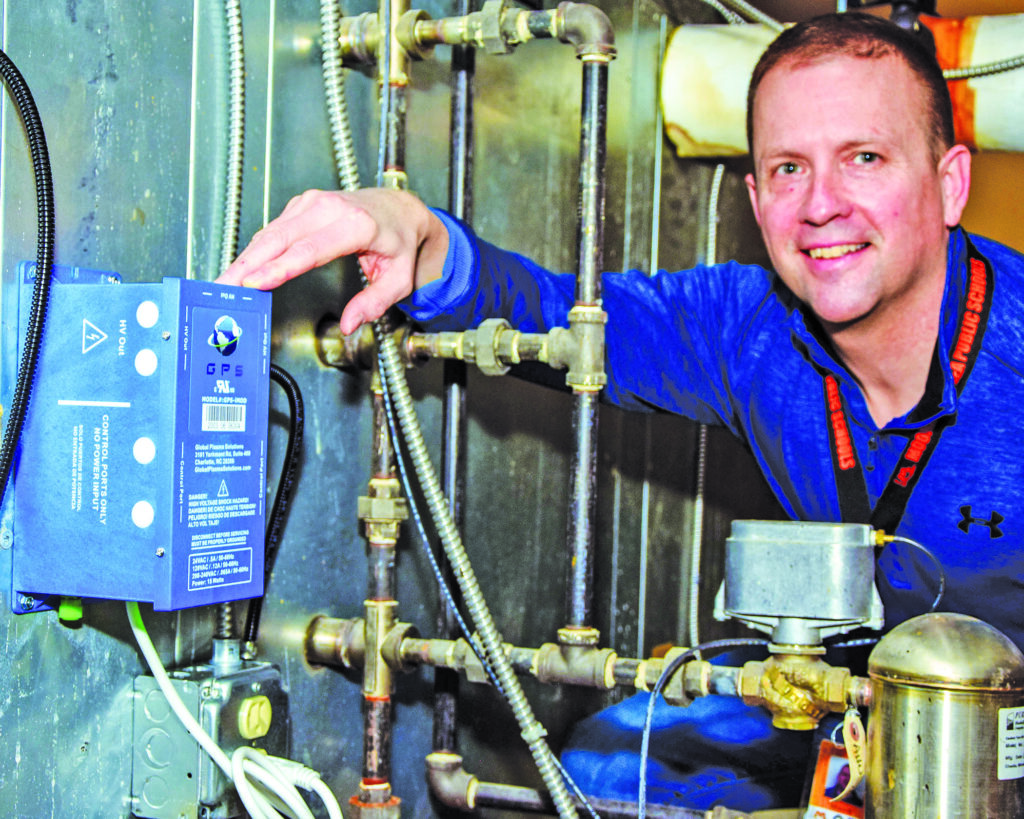
The Moorhead school district has insured that returning students will breathe clean, virus-free air with installation of 223 needlepoint ionization filters throughout its facilities. Operations director Steve Moore (mask removed for photo) says it’s just one of several upgrades to combat COVID-19. (Photo/Russ Hanson.)
Nancy Edmonds Hanson
COVID-19 spreads through the air. That much is certain. As Moorhead schools have returned to full-time in-person attendance, the school district has been upgrading its air handling systems to insure its classrooms are filled with clean fresh air.
Now, as younger students are back in class and Moorhead High plans to welcome teens back March 8, operations director Steve Moore says, “Everyone is asking, ‘Is it safe to come back?’” operations director Steve Moore reports. “Yes. The air quality is excellent.” Even then, he adds, further upgrades are planned for the oldest schools that will make it even better.
Indoor air quality has moved to the top of the list of concerns as Spuds return to full-time, face-to-face instruction. Boys and girls in kindergarten through 8th grade have been gradually returned to the classroom since the semester began in January. Moorhead High students are scheduled to come back March 8.
All are breathing air that’s been tested, purified and improved since March 2020, when all Minnesota public schools were closed. Beginning with operations director Jim Smith and carried on after his retirement by Moore, the district has invested in old and new technology to clear the air. They have taken two approaches: Bringing in more fresh outside air that’s passed through high-density antimicrobial filters, and zapping invisible particles with high-tech devices called “needlepoint ionization devices: to trap floating invaders with static electricity.
Fresh air has been the first priority, says Moore. “Our goal is to bring in at least 20% of the air that circulates from outside,” he explains. Imported through the air-conditioning system, it is cooled or heated, dehumidified and then passed through MERV-8 filters. In addition to COVID-19 viruses, they trap bacteria, pollen, mold spores and microorganisms, all of which can create other problems. In use for a number of years, the filters now used by the district have been specially treated with anti-microbial agents to up their effectiveness.
Moore says that specialized testing by Nordic Environmental Services has shown that all areas, included the sometimes-problematic basement of MHS, are well below the standard acceptable level of particulates measured in parts per million – in other words, firmly within all safety standards.
The second aspect of the district’s air-handling upgrades is the installation in October of ionization units throughout every building – 223 in all. Moore compares their process to how a balloon rubbed to produce static electricity. That familiar charge attracts everything in the air, from dust to cat hair. The devices were purchased with $60,000 in state CARES Act funding.
As with so much current air-handling technology, the system is computer-driven, though it can be manually directed for specific situations.
While he emphasizes that their air is demonstrably safe, Moore notes that the district’s three oldest schools are due for big improvements in the next several years. Robert Asp and Ellen Hopkins Elementary Schools both date back to 1957, while Moorhead High was completed in 1968. The district has requested $2.6 million in CARES funding for major upgrades of their central air-handling systems; if the state awards funding, work would be completed in the summers of 2021 and 2022. “They’re safe,” he emphasizes, “but they could be even better.”
The best news of all is construction of the new high school over the next two years. “It’s an old building that has been added onto in ways that aren’t the best for the mechanical system,” he observes. “The best possible approach is that it will be torn down and constructed from the ground up. We’re going to be able to maximize the air quality from the beginning.”
That step forward, though timely, has nothing to do with the pandemic, he points out. Like replacement of cranky elements in other schools, COVID merely accelerated needed modernization. “Air quality and temperature control are essential for our students and staff to function well,” he points out. “These things have been a part of the plan from the very beginning.”


